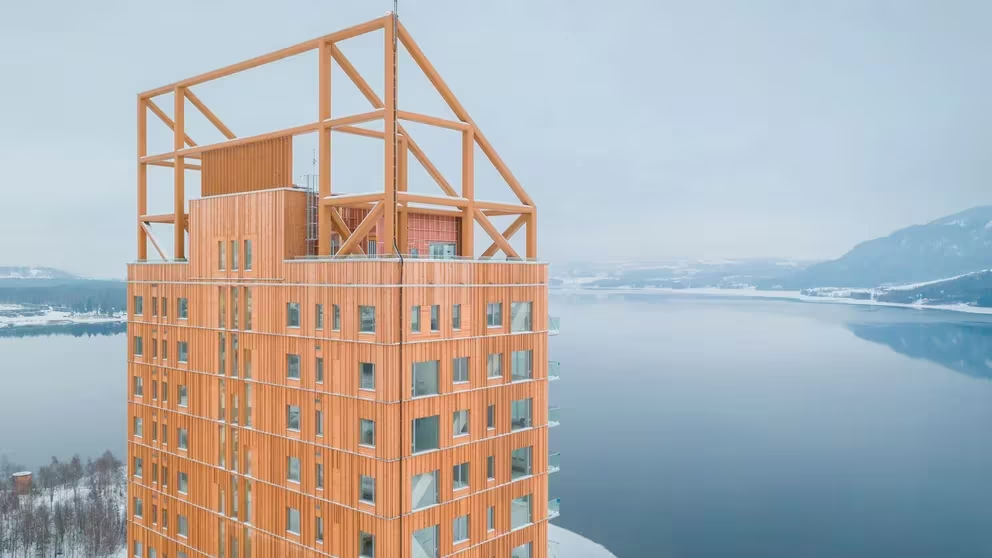
From the ground to the clouds: where they are, how and which are the tallest wooden skyscrapers in the world
The trend of building “giants” that combine residential and office spaces, providing acoustic and environmental benefits, is spreading. In Argentina, for now only buildings of up to 4 floors are being built
Wood has established itself as an efficient alternative in the face of growing environmental demands, evidenced by the race that several countries have undertaken in search of challenging heights. Six skyscrapers lead this competition, some already completed, others in an advanced phase of construction and others taking their first steps.
These buildings are erected using Cross Laminated Timber, known as the CLT (Cross Laminated Timber) system. According to experts, this construction process is faster and has a lower environmental impact compared to other materials. Wood construction also reduces noise pollution, absorbs electromagnetic radiation from electronic devices and regulates humidity inside buildings.
Currently, skyscraper and building projects with wood as a central construction element are becoming more and more noticeable.
A notable example is the Mjøstårnet in Norway, situated in Brumunddal on the shores of Lake Mjøsa. It is the tallest wooden building in the world, with 18 floors and a height of 85.4 meters. Located in a small town near the Norwegian capital, Oslo, it houses apartments, offices, a hotel, indoor pool, restaurant and common areas.
In an environment where snow becomes the protagonist, Mjøstårnet rises above the Norwegian sky. Furthermore, in this same setting, a cozy hotel operates. As the tallest wooden building in the world, it offers a unique experience, where nature and architecture merge in an impressive way.
Arthur Buchardt, a Norwegian investor, led this ambitious project, which required an investment of more than 7 million dollars.
Around the world, sustainable construction is strongly promoted, with wooden skyscrapers in countries where this practice is common or growing. Wood, as a renewable resource, plays a key role in absorbing and fixing atmospheric CO2
In three years the tallest building will debut in Switzerland, as reported by Infobae and is currently being built near Zurich and later it will be the turn of a wooden giant in Australia, in the city of Melbourne. It will be the wooden roof of Oceania.
Other wooden giants
In the United States, in the city of Minneapolis, in the state of Minnesota, renowned architect Michael Green was the brain behind the creation of the T3 building (representing Timber, Technology, Transit).
This building houses offices and commercial spaces with a total area of 21,000 square meters and is notable for its extensive use of wooden components in ceilings, floors, columns, beams and furniture. An impressive achievement was the speed of its construction, as T3 took less than 10 weeks to complete, marking a notable record in the industry.
In the Netherlands (Holland), the tallest wooden building in the country is currently under construction and in its final stages, with 21 floors intended mainly for housing. This imposing project consists of a residential tower that will rise to 73 meters high next to the Amstel River.
An environmentally significant fact is that it is estimated that the laminated parts of the building will store more than three million kilos of carbon dioxide. The investment in this work exceeds 10 million dollars.
Also in Australia, in the city of Brisbane, the largest timber-framed building in the country stands. It is called 25 King, it is 45 meters high and spread over 10 office floors.
The structure is supported by exposed wooden V columns and features an engineered wood gallery on its façade. This building rises on a north-facing core and has a ground floor that includes a wooden colonnade that houses public cafes and restaurants.
In Canada, the construction of Brock Commons Tallwood House stands out, an emblematic 18-story skyscraper, reaching 53 meters in height. Located on the Campus of the University of British Columbia in Vancouver, Canada, this building serves as a student residence.
Brock Commons, intended to house 404 students, offers four-bedroom apartments and individual studios equipped with a bathroom and kitchen. This unique building was erected in an astonishing period of 66 days and it is estimated that the wood used in its construction stores approximately 1,753 tons of CO2, in addition to avoiding the emission of 679 tons of greenhouse gases.
In Spain, the innovative WittyWood building will be erected; it will be the first on the market to be built entirely with wood as a structural element. This project will be carried out on 42 Llacuna Street, in Barcelona. WittyWood will be a workspace designed to recreate a natural environment and host a global community focused on meeting the individual needs of professionals.
The total investment necessary for its construction amounts to 12 million euros.
The building will cover 4,100 square meters of constructed area distributed over 4 floors, of which 2,600 square meters will be used for office spaces and 1,500 square meters will be used for complementary uses. One of the most notable aspects of WittyWood will be its minimal environmental impact, marking a milestone in sustainability.
In Argentina
In Argentina, there is a robust industry that has been producing glued laminated wood pieces for more than six decades. Although the innovative CLT system has not yet been massively implemented.
“Our local resources and technologies have sufficient capacity to supply the construction needs of high-rise buildings. Although there may be a way to reach the 84 meters of the Norwegians or the impressive 300 meters of the Japanese project, conceiving low-rise buildings with 3 or 4 floors is a totally feasible possibility. Possibly, the most significant barrier to overcome lies in cultural aspects, says Diego García Pezzano, head of the architecture department of the Argentine Chamber of Wood (Cadamda).


IT MAY INTEREST YOU
 The discovery of methane-producing bacteria in trees rethinks the ecological role of forests
The discovery of methane-producing bacteria in trees rethinks the ecological role of forests
Pioneering study shows trees surprising internal microbial diversity and potential influence on global climate, driving novel strategies for agricultural and forestry management
 The forest of the oldest shadows: the story of the petrified trees
The forest of the oldest shadows: the story of the petrified trees
One of the natural treasures of Río Negro turns 23 years old under the protection law that allows its conservation. Where it is and how it was formed. Río Negro celebrates 23 years of conservation in the petrified forest as a Protected Natural Area (ANP). It is a space of 625 hectares that protects an exceptional site of fossil trunks that date back more than 60 million years.
 Free seminar on the implementation of the European EUDR regulation on deforestation-free wood products
Free seminar on the implementation of the European EUDR regulation on deforestation-free wood products
The Argentine Forestry Association (AFoA) organizes the seminar «EUDR in Forest Products: Current status of implementation. Regulatory requirements and private experiences", which will take place on Wednesday, November 26, from 11:00 a.m. to 12:00 p.m., via Zoom, with live streaming on YouTube. The European Regulation on Deforestation-Free Products (EUDR) will enter into force on December 31, 2025 and will impose new requirements for forest products entering the European Union market.





















